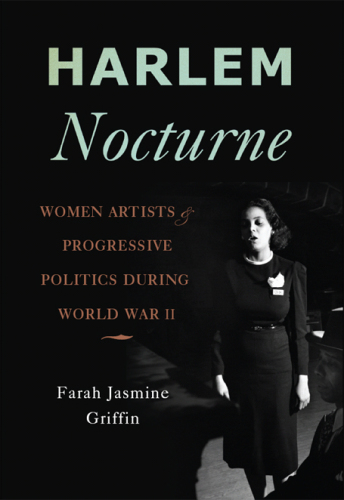
Harlem Nocturne
Women Artists and Progressive Politics During World War II
کتاب های مرتبط
- اطلاعات
- نقد و بررسی
- دیدگاه کاربران
نقد و بررسی

July 1, 2013
Griffin’s triptych focuses on dancer Pearl Primus, writer Ann Petry, and musician Mary Lou Williams—African-American political activists and artists who were innovative and influential during the 1940s, the era of the Double Victory Campaign (Victory at Home and Abroad), as black Americans “fought not only overseas for their country but also to be recognized as citizens at home.” Devoting a section to each artist, Columbia University professor Griffin provides biographical details and a discerning assessment of particular works, among them Primus’s “Strange Fruit,” Petry’s The Street, Williams’s Zodiac Suite, and delineates their historical, social, and personal milieu. In placing the women’s artistic endeavors squarely in the context of their political activities in the midst of the Double V Campaign, Griffin adds a fresh and provocative perspective to their creative work, but the book bursts at the seams. There’s almost a whole history of Harlem, as well as a who’s who of friends, husbands, employers, and contemporaries of the primary subjects (Katherine Dunham, Dinah Washington, Benjamin Davis, and others). Still, the book constitutes a giant step to securing the place all three subjects merit in American cultural history. Fully accessible to general readers, it will be mined by future scholars. Agent: Loretta Barrett, Lorretta Barrett Books.

July 1, 2013
Griffin (English/Columbia Univ.; If You Can't Be Free, Be a Mystery: In Search of Billie Holiday, 2001) explores the brief period of opportunity in the 1940s when the remarkable talents of Pearl Primus, Ann Petry and Mary Lou Williams changed art and society. Unlike the Jazz Age and the Harlem Renaissance, when people with talent flocked to Harlem, the war years fostered homegrown talent and enabled artists the freedom to mix their art with politics. The music, dance and writing of these three women, mixed with their politics, helped to usher in the modern civil rights movement. Four factors laid the foundation for this grand awakening: World War II, the second great migration from the South, the Popular Front in politics and culture, and the Double V Campaign. With Double V (Victory at Home and Abroad), black Americans insisted on their social and civil rights while fighting for their country overseas. The author meticulously shows how each woman used and expanded her art to increase awareness of a society that had been ignored and abused too long. Their extraordinary talents ensured that she would find abundant information about each, and Griffin effortlessly relates each story. All three women were associated with communist activities, but only Primus was an actual party member. In a period when class differences were finally being threatened, it was the communists who attracted the downtrodden and taught them how to affect politics with the tools at their disposal. Petry, Primus and Williams exposed the limits of the democracy of their time while unceasingly clinging to the firm belief that these wrongs could be righted. An engaging biography of three remarkable women who taught art to reflect life.
COPYRIGHT(2013) Kirkus Reviews, ALL RIGHTS RESERVED.

July 1, 2013
Many readers are likely to be unfamiliar with Pearl Primus (1919-94), Ann Petry (1908-97), and Mary Lou Williams (1910-81). Yet as World War II raged overseas, these three African American artists were mothers of social change in the United States. All three came to Harlem in the 1940s with the intent of pursuing their dreams--for Primus, dance; for Petry, authorship; and for Williams, jazz composition and performance. In turn Harlem shaped them and their ambitions. Griffin (English, comparative literature, & African American studies, Columbia Univ.) has done her research, and it shows as she demonstrates how these women's passion for their crafts became a passion, as well, for creating social change and promoting democracy in America. These artists produced cathartic work that compelled others, who might otherwise have remained oblivious to their progressive messages, to listen to and witness not just their art but their activism. VERDICT It is refreshing to learn about Harlem's history beyond its well-known Renaissance and to be reminded of the essential roles African Americans, women, and artists have played in U.S. history. Readers of African American, U.S., urban, or cultural history and those studying feminism, female artists, and activism will benefit from these stories.--Cicely Douglas, Palm Beach Cty. Lib. Syst., FL
Copyright 2013 Library Journal, LLC Used with permission.

September 1, 2013
Scholar Griffin portrays three groundbreaking, once celebrated, subsequently overlooked African American women artists who were inspired by 1940s Harlem, where creative ferment confronted social injustice. Pearl Primus was a premed student turned soaring dancer and innovative choreographer, who earned her PhD in dance education. Combining athleticism and grace to profound effect, Primus drew on African and Caribbean traditions to represent the dignity and strength of black people and to express their longing for freedom. Ann Petry, a fourth-generation New Englander, became an editor and columnist for the radical Harlem newspaper, People's Voice, and channeled her concerns about gender, race, and class inequities into her novel, The Street (1946), the first book by a black woman to sell a million copies. Deeply spiritual, highly influential jazz pianist and composer Mary Lou Williams saw black music as . . . a gift to all humankind because it provided a way through pain and suffering to beauty and joy. Griffin's straight-ahead accounts of the remarkable lives of these clarion and valiant artists illuminate their exceptional vision, talent, and resoluteness in overcoming formidable barriers.(Reprinted with permission of Booklist, copyright 2013, American Library Association.)

























دیدگاه کاربران